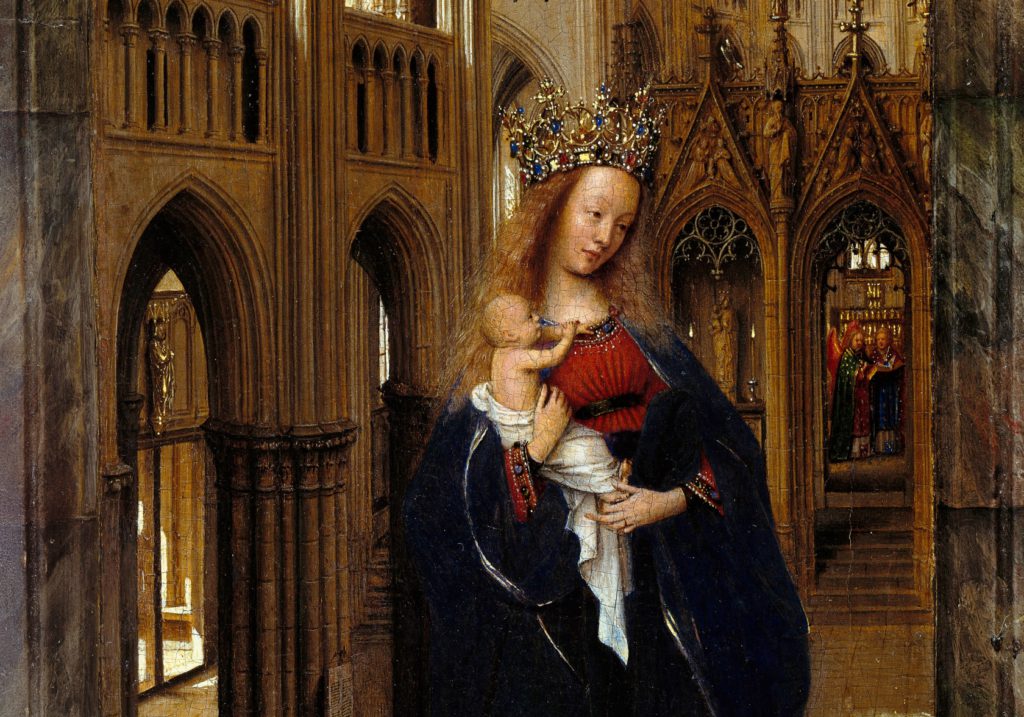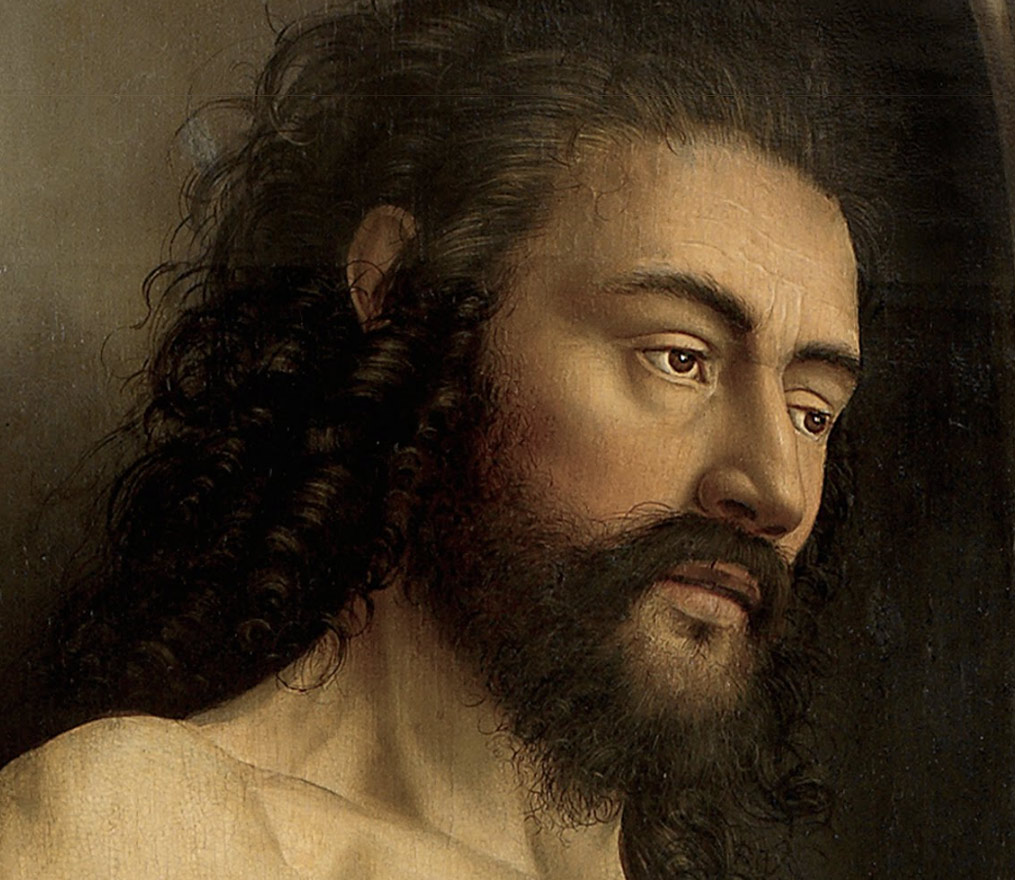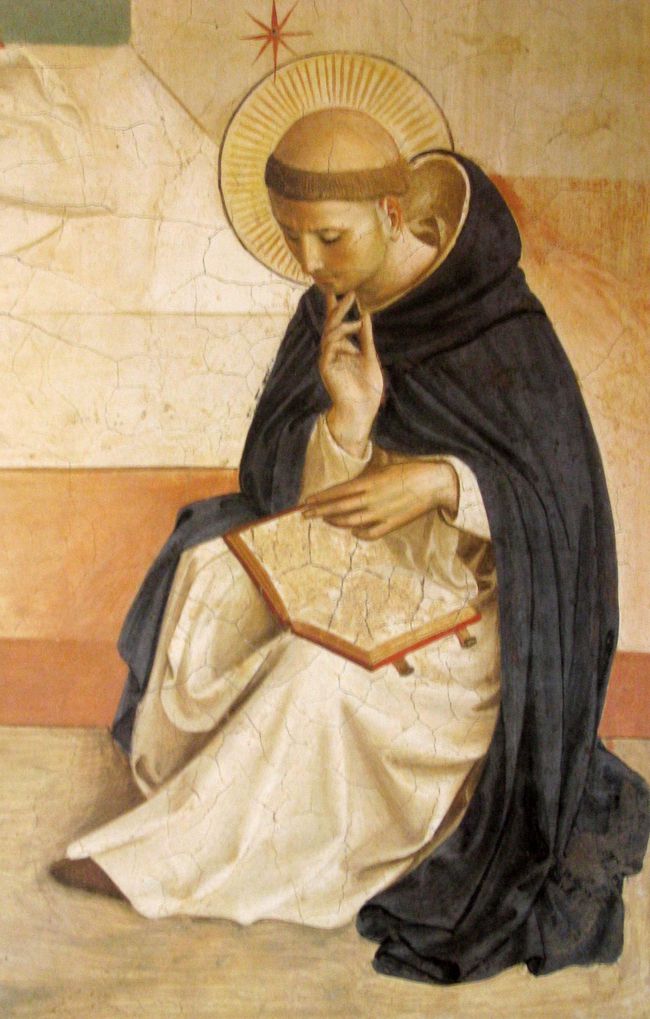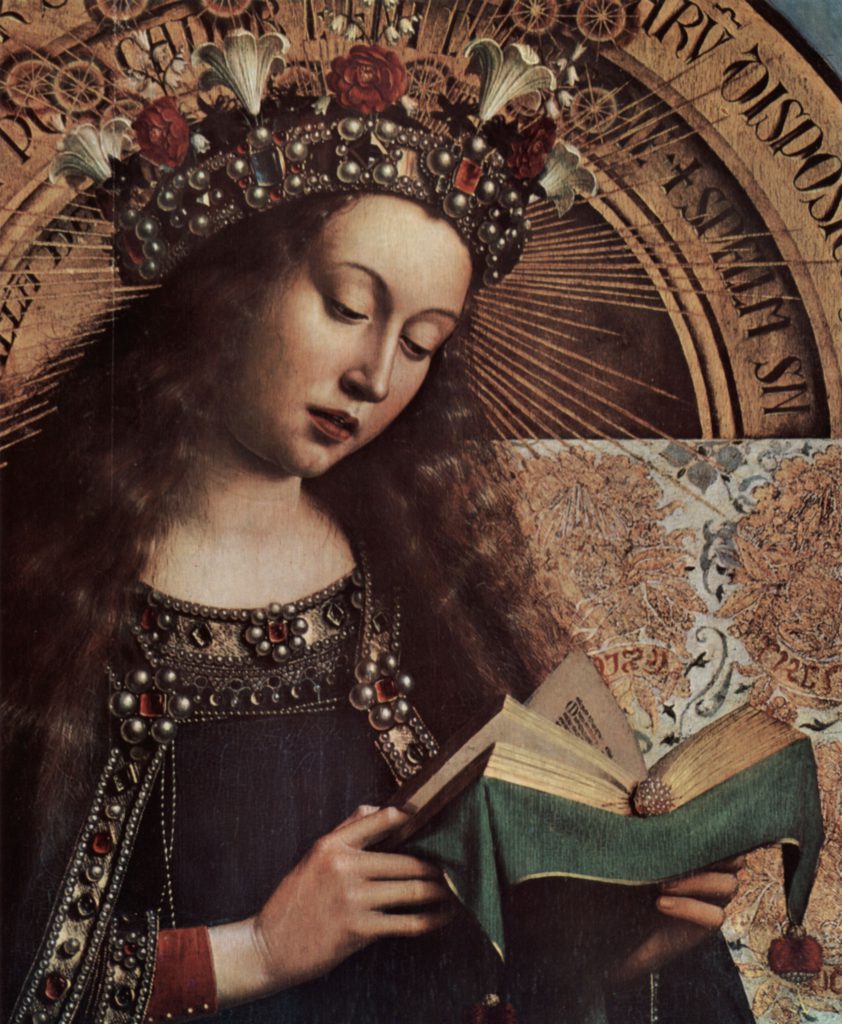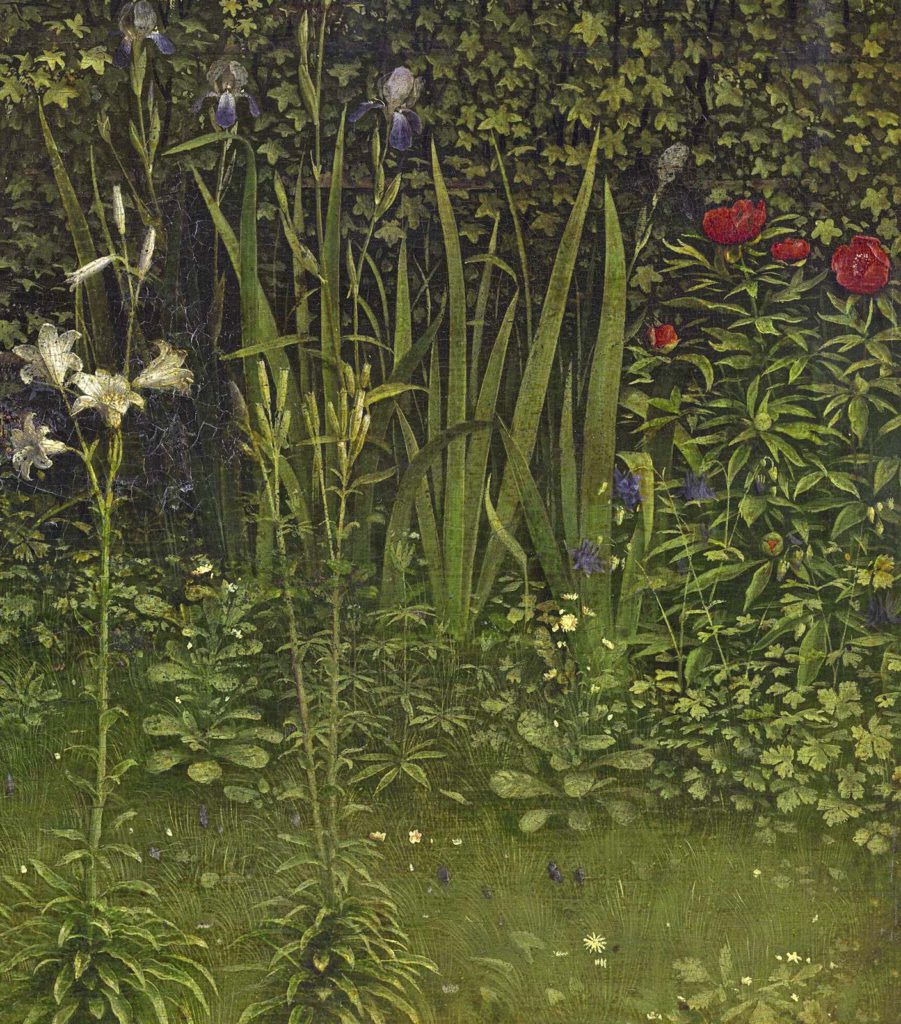Étiquette : primitives
Van Eyck, a Flemish Painter using Arab Optics?

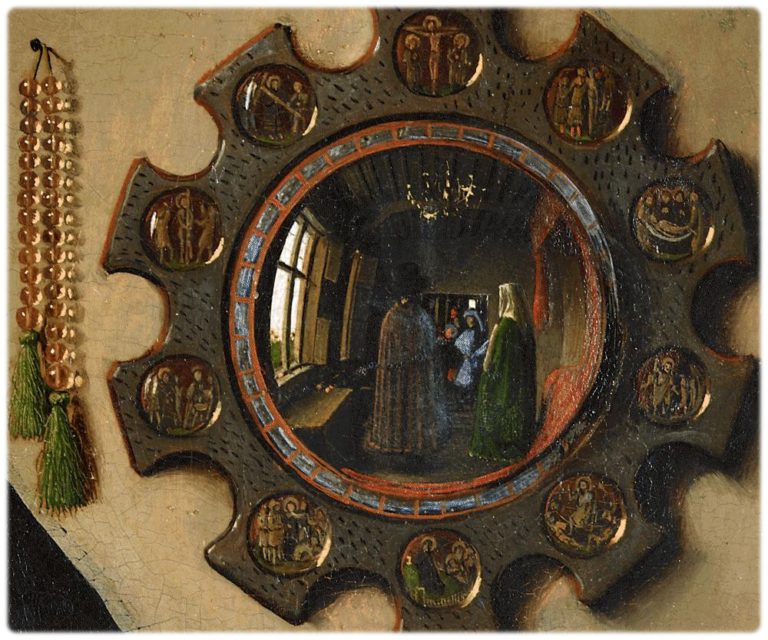
What follows is an edited transcript of a lecture by Karel Vereycken on the subject of “Perspective in XVth-century Flemish religious painting”.
It was delivered at the international colloquium “La recherche du divin à travers l’espace géométrique” (The quest for the divine through geometrical space) at the Paris Sorbonne University on April 26-28, 2006, under the direction of Luc Bergmans, Department of Dutch Studies (Paris IV Sorbonne University).
Introduction
« Perspective in XVth-century Flemish religious painting ». At first glance, this title may seem surprising. While the genius of fifteenth-century Flemish painters is universally attributed to their mastery of drying oil and their intricate sense of detail, their spatial geometry as such is usually identified as the very counter-example of the “right perspective”.
Disdained by Michelangelo and his faithful friend Vasari, the Flemish « primitives » would never have overcome the medieval, archaic and empirical model. For the classical “narritive”, still in force today, stipulates that only « Renaissance » perspective, obeying the canon of « linear », “mathematical” perspective, is the only « right », and the “scientific” one.
According to the same narrative, it was the research carried out around 1415-20 by the Duomo architect Filippo Brunelleschi (1377-1446), superficially mentioned by Antonio Tuccio di Manetti some 60 years later, which supposedly enabled Leon Battista Alberti (1404-1472), proclaiming himself Brunelleschi’s intellectual heir, to invent « perspective ».

In 1435, in De Pictura, a book entirely devoid of graphic illustration, Alberti is said to have formulated the premises of a perspectivist canon capable of representing, or at least conforming to, our modern notions of Cartesian space-time (NOTE 1), a space-time characterized as « entirely rational, i.e. infinite, continuous and homogeneous », « in one word, a purely mathematical space [dixit Panofsky] » (NOTE 2)
Long afterwards, in a drawing from the Codex Madrid, Leonardo da Vinci (1452-1519) attempted to unravel the workings of this model.
But in the same manuscript, he rigorously demonstrated the inherent limitations of the Albertian Renaissance perspectivist canon.
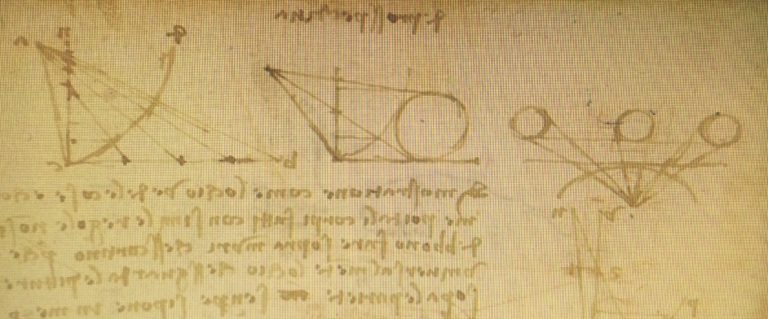
The drawing on f°15, v° clearly shows that the simple projection of visual pyramid cross-sections on a plane paradoxically causes their size to increase the further they are from the point of vision, whereas reality would require exactly the opposite. (NOTE 3)
With this in mind, Leonardo began to question the mobility of the eye and the curvilinear nature of the retina. Refusing to immobilize the viewer on an exclusive point of vision (NOTE 4), Leonardo used curvilinear constructions to correct these lateral deformations. (NOTE 5) In France, Jean Fouquet and others worked along the same lines.
But Leonardo’s powerful arguments were ignored, and he was unable to prevent this rewriting of history.
Despite this official version of art history, it should be noted that at the time, Flemish painters were elevated to pinnacles by Italy’s greatest patrons and art connoisseurs, specifically for their ability to represent space.
Bartolomeo Fazio, around the middle of the 15th century, observed that the paintings of Jan van Eyck, an artist billed as the « principal painter of our time », showed « tiny figures of men, mountains, groves, villages and castles rendered with such skill that one would think them fifty thousand paces apart. » (NOTE 6)
Such was their reputation that some of the great names in Italian painting had no qualms about reproducing Flemish works identically. I’m thinking, for example, of the copy of Hans Memlinc‘s Christ Crowned with Thorns at the Genoa Museum, copied by Domenico Ghirlandajo (Philadelphia Museum).
But post-Michelangelo classicism deemed the non-conformity of Flemish spatial geometry with Descartes’ « extended substance » to be an unforgivable crime, and any deviation from, or insubordination to, the « Renaissance » perspectivist canon relegated them to the category of « primitives », i.e. « empiricists », clearly devoid of any scientific culture.
Today, ironically, it is almost exclusively those artists who explicitly renounce all forms of perspectivist construction in favor of pseudo-naïveté, who earn the label of modernity…

In any case, current prejudices mean that 15th-century Flemish painting is still accused of having ignored perspective.
It’s true, however, that at the end of the XIVth century, certain paintings by Melchior Broederlam (c. 1355-1411) and others by Robert Campin (1375-1444) (Master of Flémalle) show the viewer interiors where plates and cutlery on tables threaten to suddenly slide to the floor.
Nevertheless, it must be admitted that whenever the artist « ignores » or disregards the linear perspective scheme, he seems to do so more by choice than by incapacity. To achieve a limpid composition, the painter prioritizes his didactic mission to the detriment of all other considerations.
For example, in Campin’s Mérode Altarpiece, the exaggerated perspective of the table clearly shows that the vase is behind the candlestick and book.
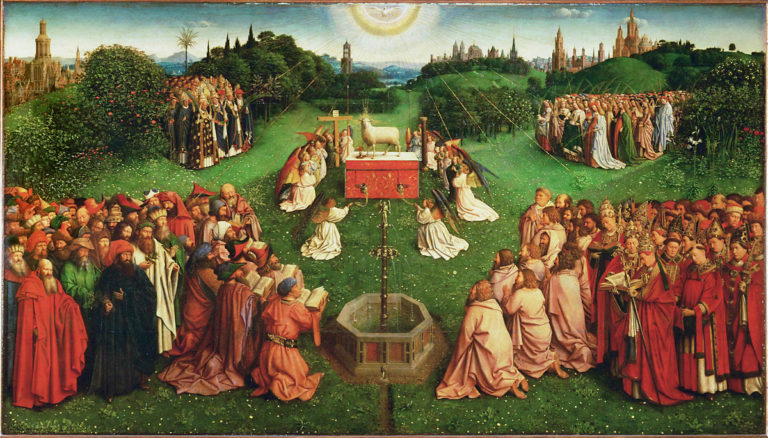
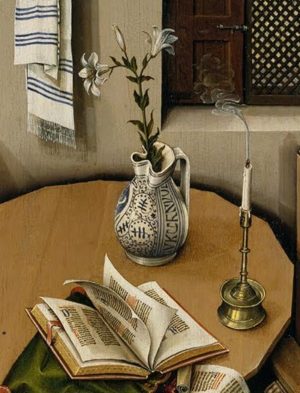
Jan van Eyck’s Lam Gods (Mystic Lamb) in Ghent is another example.
Never could so many figures, with so much detail and presence, be shown with a linear perspective where the figures in the foreground would hide those behind. (NOTE 7)
But the intention to approximate a credible sense of space and depth remains.
If this perspective seems flawed by its linear geometry, Campin imposes an extraordinary sense of space through his revolutionary treatment of shadows. As every painter knows, light is painted by painting shadow.
In Campin’s work, every object and figure is exposed to several sources of light, generating a darker central shadow as the fruit of crossed shadows.
Van Eyck influenced by Arab Optics?
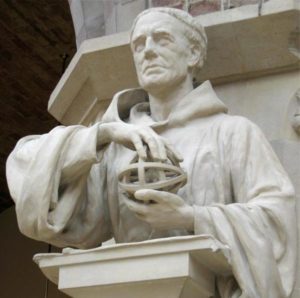
Roger Bacon, statue in Oxord.
This new treatment of light-space has been largely ignored. However, there are several indications that this new conception was partly the result of the influence of « Arab » science, in particular its work on optics.
Translated into Latin and studied from the XIIth century onwards, their work was developed in particular by a network of Franciscans whose epicenter was in Oxford (Robert Grosseteste, Roger Bacon, etc.) and whose influence spread to Chartres, Paris, Cologne and the rest of Europe.
It should be noted that Jan van Eyck (1395-1441), an emblematic figure of Flemish painting, was ambassador to Paris, Prague, Portugal and England.
I’ll briefly mention three elements that support this hypothesis of the influence of Arab science.

Curved mirrors
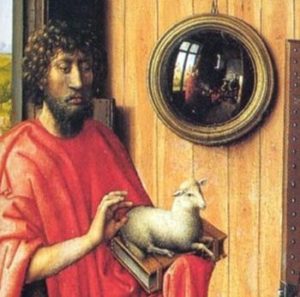
Robert Campin (master of Flémalle) in the Werl Triptych (1438) and Jan van Eyck in the Arnolfini portrait (1434), each feature convex mirrors of considerable size.
It is now certain that glaziers and mirror-makers were full members of the Saint Luc guild, the painters’ guild. (NOTE 8)
But it is relevant to know that Campin, now recognized as having run the workshop in Tournai where the painters Van der Weyden and Jacques Daret were trained, produced paintings for the Franciscans in this city. Heinrich Werl, who commissioned the altarpiece featuring the convex mirror, was an eminent Franciscan theologian who taught at the University of Cologne.

Artistic representation of Ibn Al-Haytam (Alhazen)
These convex and concave (or ardent) mirrors were much studied during the Arab renaissance of the IXth to XIth centuries, in particular by the Arab philosopher Al-Kindi (801-873) in Baghdad at the time of Charlemagne.
Arab scientists were not only in possession of the main body of Hellenic work on optics (Euclid‘s Optics, Ptolemy‘s Optics, the works of Heron of Alexandria, Anthemius of Tralles, etc.), but it was sometimes the rigorous refutation of this heritage that was to give science its wings.
After the decisive work of Ibn Sahl (Xth century), it was that of Ibn Al-Haytam (Latin name : Alhazen) (NOTE 9) on the nature of light, lenses and spherical mirrors that was to have a major influence. (NOTE 10)
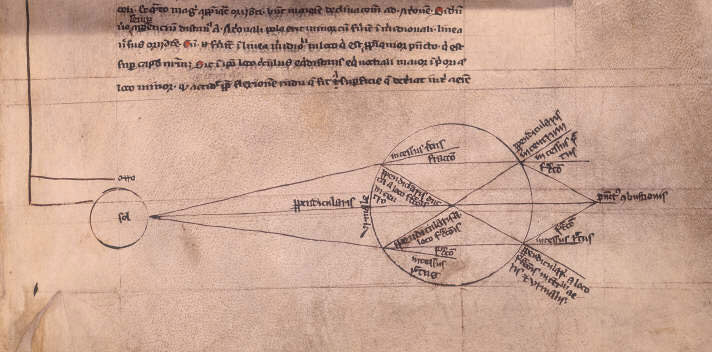
As mentioned above, these studies were taken up by the Oxford Franciscans, starting with the English bishop of Lincoln, Robert Grosseteste (1168-1253).
In De Natura Locorum, for example, Grosseteste shows a diagram of the refraction of light in a spherical glass filled with water. And in his De Iride he marvels at this science which he connexts to perspective :
« This part of optics, so well understood, shows us how to make very distant things appear as if they were situated very near, and how we can make small things situated at a distance appear to the size we desire, so that it becomes possible for us to read the smallest letters from incredible distances, or to count sand, or grains, or any small object.«
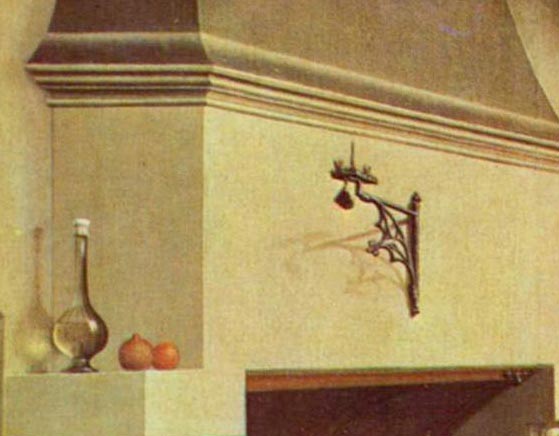
Grosseteste’s pupil Roger Bacon (1212-1292) wrote De Speculis Comburentibus, a specific treatise on « Ardent Mirrors » which elaborates on Ibn Al-Haytam‘s work.
Flemish painters Campin, Van Eyck and Van der Weyden proudly display their knowledge of this new scientific and technological revolution metamorphosed into Christian symbolisms.
Their paintings feature not only curved mirrors but also glass bottles, which they use as a metaphor for the immaculate conception.
A Nativity hymn of that period says:
« As through glass the ray passed without breaking it, so of the Virgin Mother, Virgin she was and virgin she remained… » (NOTE 11)
The Treatment of Light
In his Discourse on Light, Ibn Al-Haytam develops his theory of light propagation in extremely poetic language, setting out requirements that remind us of the « Eyckian revolution ». Indeed, Flemish « realism » and perspective are the result of a new treatment of light and color.
Ibn Al-Haytam:
« The light emitted by a luminous body by itself -substantial light- and the light emitted by an illuminated body -accidental light- propagate on the bodies surrounding them. Opaque bodies can be illuminated and then in turn emit light. »
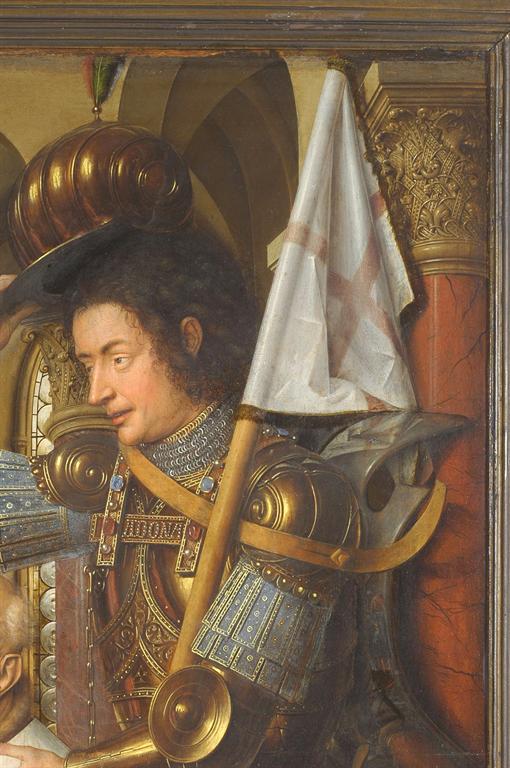
This physical principle, theorized by Leonardo da Vinci, is omnipresent in Flemish painting. Just look at the images reflected in the helmet of St. George in Van Eyck‘s Madonna to Canon van der Paele (NOTE 12).
In each curved surface of Saint George’s helmet, we can identify the reflection of the Virgin and even a window through which light enters the painting.
The shining shield on St. George’s back reflects the base of the adjacent column, and the painter’s portrait appears as a signature. Only a knowledge of the optics of curved surfaces can explain this rendering.
Ibn Al-Haytam:
« Light can penetrate transparent bodies: water, air, crystal and their counterparts. »
And :
« Transparent bodies have, like opaque bodies, a ‘receiving power’ for light, but transparent bodies also have a ‘transmitting power’ for light.«
Isn’t the development of oil mediums and glazes by the Flemish an echo of this research? Alternating opaque and translucent layers on very smooth panels, the specificity of the oil medium alters the angle of light refraction.
In 1559, the painter-poet Lucas d’Heere referred to van Eyck‘s paintings as « mirrors, not painted scenes.«
Binocular perspective
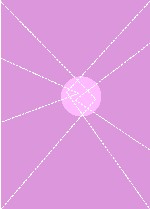
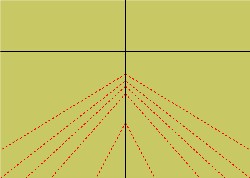

Before the advent of « right » central linear perspective, art historians sought a coherent explanation for its birth in the presence of several seemingly disparate vanishing points by theorizing a so-called central « fishbone » perspective.
In this model, a number of vanishing lines, instead of coinciding in a single central vanishing point on the horizon, either end up in a « vanishing region » (NOTE 13), or align with what some call a vertical « vanishing axis », forming a kind of « fishbone ».
French Professor Dominique Raynaud, who worked for years on this issue, underscores that « all medieval treatises on perspective address the question of binocular vision », notably the Polish scholar Witelo (1230-1280) (NOTE 15) in his Perspectiva (I,27), an insight he also got from the works of Ibn Al-Haytam.
Witelo presents a figure to defend the idea that
« the two forms, which penetrate two homologous points of the surface of the two eyes, arrive at the same point of the concavity of the common nerve, and are superimposed at this point to become one » (Perspectiva, III, 37).
A similar line of reasoning can be found in Roger Bacon‘s Perspectiva Communis, written by John Pecham, Archbishop of Canterbury (1240-1290) for whom:
« the duality of the eyes must be reduced to unity »
So, as Professor Raynaud proposed, if we extend the famous vanishing lines (i.e., in our case, the « fish bones ») until they intersect, the « vanishing axis » problem disappears, as the vanishing lines meet. Interestingly, the result is a perspective with two vanishing points in the central region!
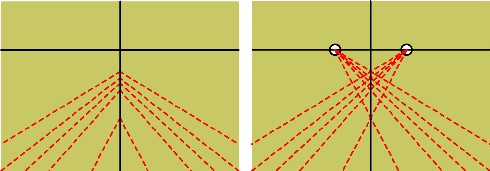
Suddenly, the diagrams drawn up to demonstrate the « empiricism » of the Flemish painters, if viewed from this point of view, reveal a legitimate construction probably based on optics as transmitted by Arab science and rediscovered by Franciscan networks and others.
Two paintings by Jan van Eyck clearly demonstrate that he followed this approach: The Madonna with Canon van der Paele of 1436 and the Dresden Tryptic of 1437.
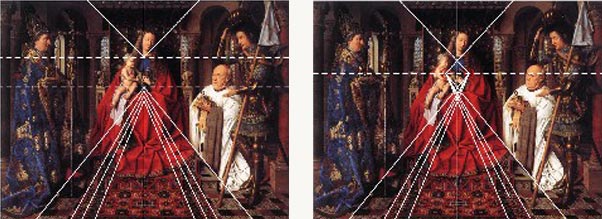

What seemed a clumsy, empirical approach in the form of a « fishbone » perspective (left) turns out to be a binocular perspective construction.
Was this type of perspective specifically Flemish?
A close examination of works by Ghiberti, Donatello and Paolo Uccello, generally dating from the first half of the XVth Century, reveals a mastery of the same principle.
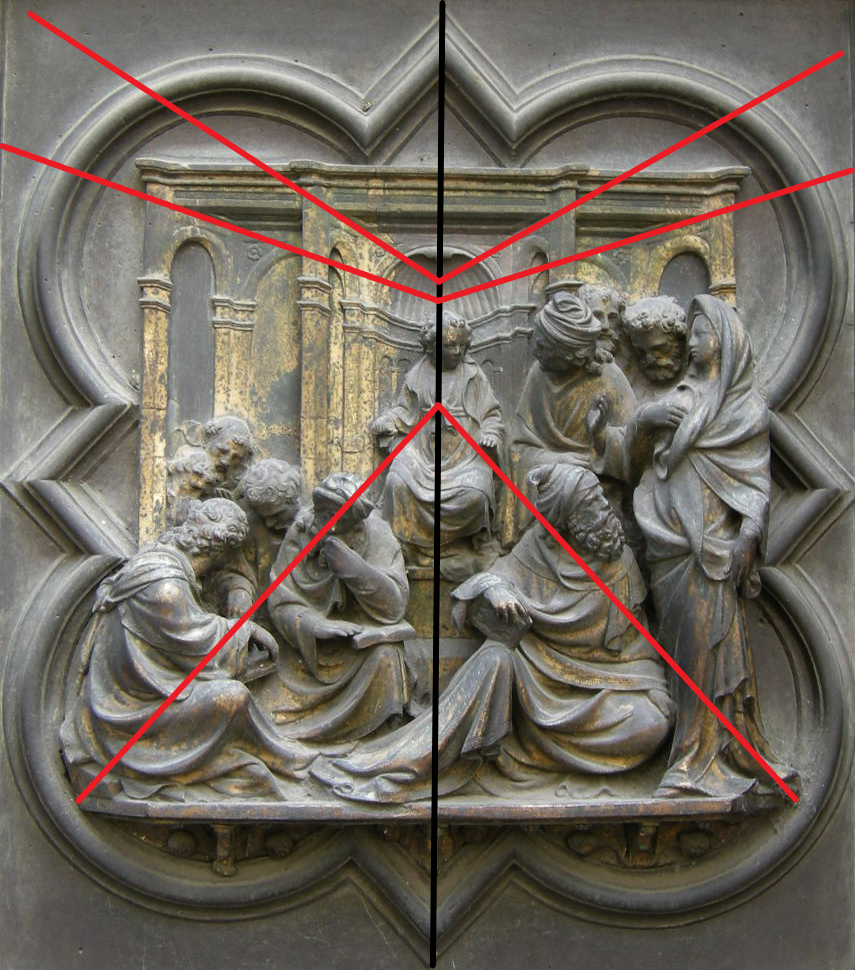

Cusanus
But this whole demonstration is merely a look into the past through the eyes of modern scientific rationality. It would be a grave error not to take into account the immense influence of the Rhenish (Master Eckhart, Johannes Tauler, Heinrich Suso) and Flemish (Hadewijch of Antwerp, Jan van Ruusbroec, etc.) « mystics ».
This trend began to flourish again with the rediscovery of the Christianized neo-Platonism of Dionysius the Areopagite (Vth-VIth century), made accessible… by the new translations of the Franciscan Grosseteste in Oxford.
The spiritual vision of the Aeropagite, expressed in a powerful imagery language, is directly reminiscent of the metaphorical approach of the Flemish painters, for whom a certain type of light is simply the revelation of divine grace.
In On the Heavenly Hierarchy, Dionysius immediately presents light as a manifestation of divine goodness. It ennobles us and enables us to enlighten others:
« Let those who are illuminated be filled with divine clarity, and the eyes of their understanding trained to the work of chaste contemplation; finally, let those who are perfected, once their primitive imperfection has been abolished, share in the sanctifying science of the marvelous teachings that have already been manifested to them; similarly, let the purifier excel in the purity he communicates to others; let the illuminator, gifted with a greater penetration of spirit, equally fit to receive and transmit light, happily flooded with sacred splendor, pour it out in pressing streams on those who are worthy… » [Chap. III, 3]
Let’s think again of the St. George in Van Eyck‘s Madonna to Canon van der Paele, which indeed pours forth the multiple images of the Virgin who enlightens him.
This theo-philosophical trend reached full maturity in the work of Cardinal Nicolas of Cusa (Cusanus) (1401-1464) (NOTE 16), embodying the extremely fruitful encounter of this « negative theology » with Greek science, Socratic knowledge and Christian Humanism.

In contrast to both a science « without a hypothesis of God » and a metaphysics with an esoteric drift, an agapic love leads it to the education of the greatest number, to the defense of the weak and the humiliated.
The Brothers and Sisters of the Common Life, educating Erasmus of Rotterdam and inspiring Cusanus, are the best example of this.
But let’s sketch out some of Cusanus’ key ideas on painting.
In De Icona (The Vision of God) (1453), which he sent to the Benedictine monks of the Tegernsee, Cusanus condenses his fundamental work On Learned Ignorance (1440), in which he develops the concept of the coincidence of opposites. His starting point was a self-portrait of his friend « Roger », the Flemish painter Rogier van der Weyden, which he sent together with his sermon to the monks.
This self-portrait, like the multiple faces of Christ painted in the XVth century, uses an « optical illusion » to create the effect of a gaze that fixes the viewer, regardless of his or her position in front of the altarpiece.
In De Icona, written as a sermon, Cusanus asks monks to stand in a semicircle around the painting and watch this gaze pursue them as they move along the segment of the curve. In fact, he elaborates a pedagogical paradox based on the fact that the Greek name for God, Theos, has its etymological origin in the verb theastai (to see, to look at).
As you can see, he says, God looks at you personally, and his gaze follows you everywhere. He is therefore one and many. And even when you turn away from him, his gaze falls on you. So, miraculously, although he looks at everyone at the same time, he nevertheless establishes a personal relationship with each one. If « seeing » for God is « loving », God’s point of vision is infinite, omniscient and omnipotent love.
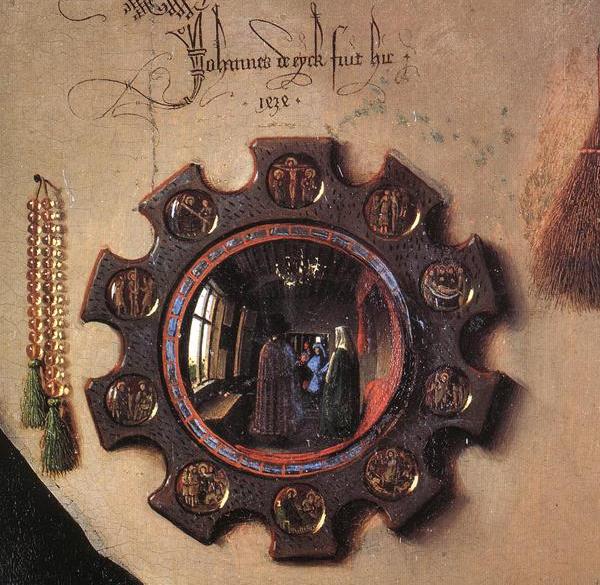
A parallel can be drawn here with the spherical mirror at the center of Jan van Eyck’s painting The Arnolfini portrait, painted in 1434, nineteen years before this sermon.
Firstly, this circular mirror is surrounded by the ten stations of Christ’s Passion, juxtaposed by a rosary, an explicit reference to God.
Secondly, it reveals a view of the entire room, an image that completely escapes the linear perspective of the foreground. A view comparable to the allcompassing « Vision of God » developed by Cusanus.
Finally, we see two figures in the mirror, but not the image of the painter behind his easel. These are undoubtedly the two witnesses to the wedding. Instead of signing his painting with « Van Eyck invent. », the painter signed his painting above the mirror with « Van Eyck was here » (NOTE 17), identifying himself as a witness.
As Dionysius the Aeropagite asserted:
« [the celestial hierarchy] transforms its adepts into so many images of God: pure and splendid mirrors where the eternal and ineffable light can shine, and which, according to the desired order, reflect liberally on inferior things this borrowed brightness with which they shine. » [Chap. III, 2]
The Flemish mystic Jan van Ruusbroec (1293-1381) evokes a very similar image in his Spiegel der eeuwigher salicheit (Mirror of eternal salvation) when he says:
« Ende Hi heeft ieghewelcs mensche ziele gescapen alse eenen levenden spieghel, daer Hi dat Beelde sijnre natueren in gedruct heeft. » (And he created each human soul as a living mirror, in which he imprinted the image of his nature).
And so, like a polished mirror, Van Eyck’s soul, illuminated and living in God’s truth, acts as an illuminating witness to this union. (NOTE 18)
So, although the Flemish painters of the XVth century clearly had a solid scientific foundation, they choose such or such perspective depending on the idea they wanted to convey.
In essence, their paintings remain objects of theo-philosophical speculation or as you like « intellectual prayer », capable of praising the goodness, beauty and magnificence of a Creator who created them in His own image. By the very nature of their approach, their interest lay above all in the geometry of a kind of « paradoxical space-light » capable, through enigma, of opening us up to a participatory transcendence, rather than simply seeking to « represent » a dead space existing outside metaphysical reality.
The only geometry worthy of interest was that which showed itself capable of articulating this non-linearity, a « divine » or « mystical » perspective capable of linking the infinite beauty of our commensurable microcosm with the immeasurable goodness of the macrocosm.
Thank you,
NOTES:
- Recently, Italian scholars have pointed to the role of Biagio Pelacani Da Parma (d. 1416), a professor at the University of Padua near Venice, in imposing such a perspective, which privileged only the « geometrical laws of the act of vision and the rules of mathematical calculation ».
- Erwin Panofsky, Perspective as Symbolic Form, p.41-42, Les Éditions de Minuit, Paris, 1975.
- Institut de France, Manuscrit E, 16 v° « the eye [h] perceives on the plane wall the images of distant objects greater than that of the nearer object. »
- Leonardo understands that Albertian perspective, like anamorphosis, condemns the viewer to a single, immobile point of vision.
- See, for example, the slight enlargement of the apostles at the ends of Leonardo da Vinci’s Last Supper in the Milan refectory.
- Baxandall, Bartholomaeus Facius on painting, Journal of the Warburg and Courtauld Institutes, 27, (1964). Fazio is also enthusiastic about a world map (now lost) by Jan van Eyck, in which all the places and regions of the earth are depicted recognizably and at measurable distances.
- To escape this fate, Pieter Bruegel the Elder used a cavalier perspective, placing his horizon line high up.
- Lionel Simonot, Etude expérimentale et modélisation de la diffusion de la lumière dans une couche de peinture colorée et translucide. Application à l’effet visuel des glacis et des vernis, p.9 (PhD thesis, Nov. 2002).
- Ibn Al-Haytam (Alhazen) (965-1039) wrote some 200 works on mathematics, astronomy, physics, medicine and philosophy. Born in Basra, after working on the development of the Nile in Egypt, he travelled to Spain. He is said to have carried out a series of highly detailed experiments on theoretical and experimental optics, including the camera obscura (darkroom), work that was later to feature in Leonardo da Vinci’s studies. Da Vinci may well have read the lengthy passages by Alhazen that appear in the Commentari of the Florentine sculptor Ghiberti. According to Gerbert d’Aurillac (the future Pope Sylvester II in 999), Bishop of Rheims, brought back from Spain the decimal system with its zero and an astrolabe, it was thanks to Gerard of Cremona (1114-c. 1187) that Europe gained access to Greek, Jewish and Arabic science. This scholar went to Toledo in 1175 to learn Arabic, and translated some 80 scientific works from Arabic into Latin, including Ptolemy’s Almagest, Apollonius’ Conics, several treatises by Aristotle, Avicenna‘s Canon, and the works of Ibn Al-Haytam, Al-Kindi, Thabit ibn Qurra and Al-Razi.
- In the Arab world, this research was taken up a century later by the Persian physicist Al-Farisi (1267-1319). He wrote an important commentary on Alhazen’s Treatise on Optics. Using a drop of water as a model, and based on Alhazen’s theory of double refraction in a sphere, he gave the first correct explanation of the rainbow. He even suggested the wave-like property of light, whereas Alhazen had studied light using solid balls in his reflection and refraction experiments. The question was now: does light propagate by undulation or by particle transport?
- Meiss, M., Light as form and symbol in some fifteenth century paintings, Art Bulletin, XVIII, 1936, p. 434.
- Note also the fact that the canon shows a pair of glasses…
- Brion-Guerry in Jean Pèlerin Viator, sa place dans l’histoire de la perspective, Belles Lettres, 1962, p. 94-96, states in obscure language that « the object of representation behaves most often in Van Eyck as a cubic volume seen from the front and from the inside. Perspectival foreshortening is achieved by constructing a rectangle whose sides form the base of four trapezoids. The orthogonals thus tend towards four distinct points of convergence, forming a ‘vanishing region' ».
- Dominique Raynaud, L’Hypothèse d’Oxford, essai sur les origines de la perpective, PUF, Paris 1998.
- Witelo was a friend of the Flemish Dominican scholar Willem van Moerbeke, a translator of Archimedes in contact with Saint Thomas Aquinas. Moerbeke was also in contact with the mathematician Jean Campanus and the Flemish neo-Platonic astronomer Hendrik Bate van Mechelen. Johannes Kepler‘s own work on human vision builds on that of Witelo.
- Cusanus was above all a man of science and theology. But he was also a political organizer. The painter Jan van Eyck fought for the same goals, as evidenced by the ecumenical theme of the Ghent polyptych. It shows the Mystic Lamb, symbolizing the sacrifice of the Son of God for the redemption of mankind, capable of reuniting a church torn apart by internal differences. Hence the presence of the three popes in the central panel, here united before the lamb. Van Eyck also painted a portrait of Cardinal Niccolo Albergati, one of the instigators of the great Ecumenical Council organized by Cusanus in Ferrara and then moved to Florence. If Cusanus called Van der Weyden « his friend Roger », it is also thought that Robert Campin may have met him, since he would have attended the Council of Basel, as did one of his commissioners, the Franciscan theologian Heinrich Werl.
- Jan Van Eyck was one of the first painters in the history of art to date and sign his paintings with his own name.
- Myriam Greilsammer’s book L’Envers du tableau, Mariage et Maternité en Flandre Médiévale (Editions Armand Colin, 1990) documents Arnolfini’s sexual escapades. Arnolfini was taken to court by one of his victims, a female servant. Van Eyck seems to have understood that the knightly Arnoult Fin, Lucchese financier and commercial representative of the House of Medici in Bruges, required the somewhat peculiar presence of the eye of the lord.
Van Eyck : True Beauty, a foretaste of Divine Wisdom
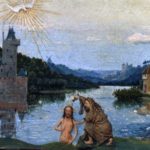
Jan Van Eyck (1390-1441). How might we grasp the intention of this great Flemish painter, despite the five hundred years of distance separating us? Apart from looking at his work, here are three tracks that I’ve been able to uncover:
- The painter was undoubtedly initiated in the art of lectio divina, the multi-leveled interpretation of sacred texts;
- The influence of the French religious thinker Hugue of Saint Victor (1096-1141), an unknown but major figure who was an inspiration for the philosopher-cardinal Nicolas of Cusa;
- The advice given to the painter by theologian Denis the Carthusian (1401-1471), the confessor of Philip the Good, Duke of Burgundy, for whom the painter carried out diplomatic missions.
The writer would highly encourage all admirers of great art to get themselves a copy of the inspiring and scholarly work Landschap in Wereldbeeld, van Van Eyck tot Rembrandt (Landscape and Worldview, from Van Eyck to Rembrandt) by the Dutch art historian Boudewijn Bakker (published in 2004 at Thoth in Bossum, Netherlands, available in English). In a very rigorous and yet accessible work, Bakker offers us a series of important clues, which allow a XXIst century viewer to gain new insights into the often “hidden” meaning of Dutch and Flemish painting. For today’s viewers, what is often surprising in these works is the use of recurring references by the painters, their sponsors, religious officials and the general public of these countries.
Paradox
Before I read Bakker’s work, the paintings of northern Europe often appeared to me to be opposed to the prevailing philosophical and religious matrix of the fifteenth century, when in reality they were its very expression. Until now, I thought that, for the most part, the world view that prevailed at the end of the Middle-Ages was one rejecting the visible world as it was known through our senses. According to a scholastic misinterpretation of St. Augustine and Plato, the world was only deception and temptation, which one might have called the devil himself. Now, and herein lies the paradox in all its force, how can we reconcile the rejection of the visible world, particularly in sight of the work of the Flemish painter Van Eyck, who was able to show us human beings animated by kindness, glowing with beauty and surrounded by pristine nature?
I thought “How dare he show us so much beauty”, whereas in his day the doctrine of faith, which had been heralded as guardian of the temple, had kept reminding us that Man, in his glaring imperfection, was no God, and systematically warned us against the temptations of this world? Were the ironic but extremely moralizing pictures of Hieronymus Bosch and Joachim Patinier not intended to make us understand, albeit with violence, and yet with humor and great craft, that the origin of sin lay precisely in our excessive attachments to worldly things and the pleasures which were believed to be derived from them?
The Coincidence of Opposites
Without explicitly referring to the method of the great theologian-philosopher, Cardinal Nicolas of Cusa, the « coincidence of opposites » (coincidentia oppositorum), that is to say the paradoxes whose seemingly irreconcilable differences can be overcome from a higher conceptual level, Bakker demonstrates that the aforementioned paradox is also only one of appearance.
In order to make sense of this, Bakker first recalls that for the Augustinian current, for whom man was created in the living image of the creator (Imago Viva Dei), nature was neither more nor less than « theophany », that is to say, for those who were able to read it, it was the revelation of a divine intention.
For this current, God revealed himself to man, not by one, but by « two books, » the first of which was none other than « the book of nature, » read through our eyes; the second being the Bible, which was accessible through our eyes and ears. With this connection in mind, Bakker emphasizes two nearly forgotten yet first-rate Christian thinkers who had unfortunately fallen into obscurity following the hegemony of Aristotelianism, which had been ushered in by St. Thomas of Aquinas in tandem with the rise of nominalism and the counter-reformation. The first is the French abbot and theologian Hugue of Saint Victor (1096-1141), one of the medieval writers whose manuscripts were widely circulated at the time, and Denis the Carthusian (1402-1471), a Dutch friend and collaborator of Nicolas of Cusa (1401-1464) and also confessor of Philip the Good, Duke of Burgundy (1396-1467).
The Lectio Divina of Nature
In respect to his interpretation of the paintings, Bakker did the work that any true art historian worthy of such a title should have necessarily done: he compared the paintings with, if they still existed, the writings of their times.
By using the writings of the time to inform his interpretation of the paintings, Bakker formulates a rigorous hypothesis around the idea that the masterpieces of Flemish painting, riddled with as many enigmas and mysteries as our beautiful cathedrals, are to be read « on several levels ». The said “four levels” was what the biblical exegesis of the day prescribed based on ancient tradition.
First, in Judaism, long before the arrival of Jesus, the study of the Torah appealed to the « doctrine of the four senses »:
- the literal meaning,
- the allegorical meaning,
- the allusive meaning, and
- the mystical meaning (possibly hidden, secret or kabalistic).
Then, Christians, especially Origen (185-254), then Ambrose of Milan in the fourth century, repeated this method with the Lectio Divina, that is to say, the exercise of spiritual reading aimed, by prayer, to penetrate a sacred text at its deepest level.
Finally, introduced in the fourth century by Ambrose, Augustine made Lectio Divina the basis of monastic prayer. It would then be taken over by Jerome, Venerable Bede, Scot Erigena, Hugue of Saint Victor, Richard of Saint Victor, Alain of Lille, Bonaventure and would impose itself upon Saint Thomas Aquinas and Bernard of Clairvaux.
Bakker takes care to specify these four levels of reading:
- The literal meaning is that which comes from the linguistic comprehension of the utterance. It tells the facts and « narrative » of a text while situating it in the context of its time;
- The allegorical meaning comes from Greek allos, meaning “other”, and agoreuein, to “say”. By stating one thing, Allegory also says another. Thus an allegory explains what a story symbolizes;
- The moral or tropological meaning (of the Latin tropos meaning « change »), offers us a lesson or advice. By understanding the figures, vices or virtues, passions or stages that the human mind must travel in its ascent to God, each person can draw on such wisdom for his own life;
- The anagogical meaning (adjective from the Greek anagogikos or elevation), is obtained by the interpretation of the Gospels, to give an idea of the last realities that will become visible at the end of time. In philosophy, for Leibniz, « anagogical induction » is something which can be traced back to a first cause.
These four meanings were formulated in the Middle Ages in a famous Latin couplet: littera gesta docet, quid credas allegoria, moralis quid agas, quo tendas anagogia (the letters teach the facts, allegory what one must believe, morality is what one must do, anagogy what one should aspire to).
The reason I bring this issue of multi-level biblical exegesis is that Bakker says, from the standpoint of this worldview in the Middle Ages, this method of interpretation was thought to apply not only to the Bible, but to visible creation as well.
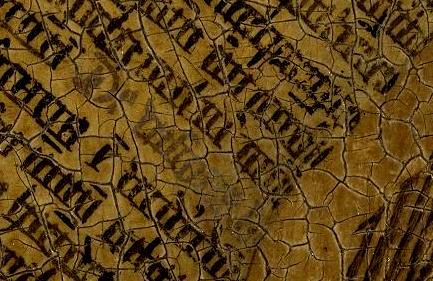
Close-up of the page of the book in front of which the Virgin in the Annunciation kneels, decorating the exterior shutters of the altarpiece of Ghent by Jan Van Eyck (1432). At the bottom of the page, one reads clearly (in red): « de visione dei », the title of the work of Nicolas de Cues of 1453.
But is this merely the instance of some kind of sentimental moment in which one is relishing in the beauty of creation for its own sake? Not at all ! Far from pantheism (a sin), it was a question of « reading », as Hugue of Saint Victor stated, « with the eyes of the mind », which « the eyes of the flesh » were not able to see, a concept that would be taken up again by Nicolas de Cusa in his work of 1543: On painting, or The Vision of God. The paradox can therefore be solved. For, in the allegory of the cavern evoked by Plato in The Republic, the man who is chained before a wall and only able to see shadows projected on the wall, was able to use his intelligence in order identify what the causes that made those shadows possible. Certainly, man cannot « know » God directly. However, by studying the effects of his action, he can come to discover his intention. It is therefore through Hugue of Saint Victor, that the Augustinian and Platonic current that inspired the Carolingian Renaissance resurfaced in Paris. In this current of thought, creation as a whole, from the anagogical point of view, was the shadow cast by a heavenly paradise and a direct reference to omnipotence, beauty and divine goodness. For Bakker:
All of these interpretations are easily illustrated by the works of Augustine, because they have inspired writers on nature throughout the Middle Ages. Augustine greatly loved the world as it appeared to us; he knew how to enjoy what he referred to as ‘the great and beautiful spaces of the city or the countryside, where the brilliance of its beauty immediately strikes the viewer. But such creation also contains innumerable ‘moral’ messages, allowing so many opportunities for a pious and acute observer to reflect on his soul and task on Earth. Time after time, Augustine emphasized this aspect when he spoke of natural phenomena. Each time, he would incite us to seek the invisible behind the visible, the eternal behind the temporal, etc. Thus the harmony that creation revealed was an indication of the peace that should rein among men. Each creature, taken separately, appeared as an example (negative or positive) which man could discern, were he willing. This applied particularly to the behavior of animals, for example. And in regards to the Earth as a whole, one should take heed and make sure to not overlook the hollows and chasms of a landscape, for they are its true wellsprings.
Hugue of Saint Victor
In France, it was with the advent of the XIIth century intellectual renaissance that centers of learning began to multiply (cathedral school, school of Abelard, school of Petit-Pont for Paris, Chartres, Laon etc…) and that an atmosphere of genuine knowledge turned France into a world-center for intellectual life. As well, numerous students originating from Germany, Italy, England, Scotland and Northern Europe all made their way to Paris in order to study first and foremost, dialectics and theology.
Hugue of Saint Victor (1096-1141) was of Saxon (or Flemish?) origin. Around 1127, he entered the house of the regular canons of Saint Victor shortly after the monastery’s founding on the outskirts of Paris.
The Victorins were distinguished from the beginning by the importance with which they regarded intellectual life. The canons of the abbey had a positive outlook on knowledge, hence the importance which they attached to their library.
The main teachers who influenced Hugue were: Raban Maur (himself a disciple of Charlemagne’s advisor, the Irishman Alcuin), Bede the Venerable, Yves de Chartres and Jean Scot Erigena and some others, perhaps Denys – The Areopagite himself of which he comments on The Celestial Hierarchy.
Propelled by an insatiable intellectual curiosity, Hugue advised his disciples to learn everything because, according to him, nothing is without use. He himself was the first to put the advice he gave to his disciples into practice. A notable part of his writings were devoted to the liberal arts, sciences, and philosophy, which he dealt with particularly in an introductory textbook on secular and sacred studies, still famous today, the Didascalicon.
His contemporaries considered him the greatest theologian of their time and gave him the glorious title of « New Augustine ». He influenced the Franciscans of Oxford (Grosseteste, Roger Bacon, etc.) whose influence on the painter Roger Campin has been well established, by whom Nicolas of Cusa was inspired.
In regards to the question of whether one should cherish or despise the world, Hugue of Saint Victor’s answer was that we must love the world, but with the condition that we never forget that we must love it with God always in sight, as a reflection of God, rather than something in and of itself.
In order for one to be able to reach such wisdom, man had to consider his existence as that of a pilgrim who was constantly breaking away from the place in which he resides, a very rich metaphor that would be found in the Flemish painters Bosch and Patinier. « The whole world is an exile for those who philosophize, » said Hugue.
Master Hugue posed the requirement of exceeding dilectio (jealous and possessive love of God) for condilectio (love welcoming and open to sharing). He advocated the idea of an agapic love turned towards others, and not centered on oneself, a love turned towards the neighbor, the love of God increased by the love of one’s neighbor. In a word: it was the idea of Christian charity and fraternal solidarity.
Hugues enumerated five spiritual exercises: reading, meditation, prayer, action and contemplation. The first granted understanding; the second provided a reflection; the third questioned, the fourth sought and the fifth found. These exercises were intended to allow one to reach the source of truth and charity, where the soul of man would be « transformed into a flame of love », resting in the hands of God in « a fullness of both knowledge and love.”
The subject which interests us here, is above all his optimistic vision of man and creation, which differed from the clichés that we have retained from medieval pessimism. For him, creation was a gift from God and the way to God was as much through reading the book of nature itself as it was from reading the Bible.
Thus, for Hugue of Saint Victor, the image that we perceive is nothing but revelation or the unveiling of God’s Divine Power, perceived
through the length, breadth, and depth of space, through the mountain ranges, the winding rivers, the rolling fields, the towering skies and the darkened chasms.
Thus, the painter who exceled in the representation of the physical universe, was only increasing his capacity to reveal the power of the creator!
The revelation of wisdom through Beauty. For Hugue, «the entirety of the sensible universe is one great book written by the hand of God” that is, created by a divine plan in which
every creature is a reflection of – not the product of human desire, but the fruit of divine providence’s will to manifest God’s great wisdom (…) Just as an illiterate looks at the lines of an open book without having knowledge of letters, a stupid and bestialized man ‘that does not understand the things that are of God’, sees in creatures only their external form, but has no understanding of their inner meaning.
To elevate oneself, Hugue proposed that the disciples of Saint Victor, all those who were able of « contemplating relentlessly, » to embrace « a spiritual vision » of the world. For his disciple, Richard of Saint Victor, the Bible and the great book of nature « share the same language and harmonize to reveal the wonders of a secret world. »
Denis the Carthusian,
the Key to Understanding Van Eyck
 Two centuries after Hugue of Saint Victor, that same flame later animated the work of theologian Denis the Carthusian (1401-1471), a native of Belgian Limburg. Under the title The beauty of the world : ordo et varietas, Bakker devotes a whole chapter of his book to it. And you’ll soon understand why.
Two centuries after Hugue of Saint Victor, that same flame later animated the work of theologian Denis the Carthusian (1401-1471), a native of Belgian Limburg. Under the title The beauty of the world : ordo et varietas, Bakker devotes a whole chapter of his book to it. And you’ll soon understand why.
Before having joined the Carthusians of Roermond in the Netherlands, Denys was trained in the spirit of the Brothers of the Common Life at the Zwolle school in the Netherlands and then completed his studies at the University of Cologne.
With Jean Gerson (1363-1429) and Nicolas of Cusa (1402-1464), and despite an often much more wordy and sometimes confused style, Denis the Carthusian was counted as among the most well-read, most copied and most published authors of his day, once the printing press had replaced the laborious work of the copyist monks. Moreover, the first book published in Flanders, was none other than the Mirror of the Sinful Soul of Denis the Carthusian, printed in 1473 by Erasmus of Rotterdam’s friend, Dirk Martens.
At the Roermond Monastery in the Netherlands, Denis wrote 150 works including commentaries on the Bible and 900 sermons. After having read one, Pope Eugene IV, who had just ordered Brunelleschi to complete the cupola of the Santa Maria del Fiore Dome in Florence, exulted: « The Mother Church is delighted to have such a son! ».
As a scholar, theologian and advisor, Denys became very influential. « A number of gentlemen, clerics and bourgeois came to consult him in his cell in Roermond where he constantly resolved doubts, difficulties and cases of conscience. (…) He was in frequent contact with the House of Burgundy and serves as an adviser to Philip the Good « , confirms the Dutch historian Huizinga in his Autumn of the Middle Ages.
According to Bakker, having written a series of works on spiritual orientation, Denis performed the role of confessor and spiritual guide for the Christian sovereign Philip the Good, Duke of Burgundy, and subsequently, that of his widow.
Together in Cologne, both attended the lecture of Flemish theologian Heymeric van de Velde (De Campo) who introduced them to the mystical theology of the Syrian Platonic monk known as Pseudo-Dionysus the Areopagite and to the work of Raymond Lulle and of Albert the Great as well. When, in 1432, Nicolas of Cusa declined an offer for the chair of Theology made to him by the University of Louvain, it was De Campo who accepted it at his request. Politically, from 1451 to 1452, Denis the Carthusian chose Nicolas of Cusa, then apostolic legate, to accompany him for several months during his tour of the Rhineland and Moselle to promote his approach to spiritual renewal, at the request of the pope.
Bakker notes that Denis had a predilection for music. He copied and illuminated scores with his hand and gave instructions on the best possible interpretation of the Psalms. His preference was for psalms praising God. And to praise the creator, Denis found images and words that would surface in the imagination of the painters of that time. However, for Denis, the beauty of God meant something deeper than mere visual appeal.
For you (Lord), ‘to be’ is ‘to be beautiful’.
Let us remember that in Christian philosophy sight was the most important of the five senses and the one which encapsulated all the others. In Denis’ Psalms, two notions prevailed. First, that of order and regularity. It was found in the celestial bodies that determined the cycles of days and years. But the Earth itself obeyed a divine order. And there Denis quoted the Book of Wisdom of Solomon (11,20) affirming: « You have ordained everything with measure, number and weight ». Then there was the idea of multiplicity and diversity. Regarding climatic phenomena, that is to say purely « physical » phenomena, Denis affirmed for example,
In the sky, lord, you generated multiple effects of pressure and air, such as clouds, winds, rains (…) and various phenomena: comets, luminous crowns, vortices, falling stars (…), frost and haze, hail, snow, the rainbow and the flying dragon.
For Denis, all this was not without a reason: it was to penetrate the divine being, his infinite greatness, his omnipotence and his love for man.
Make it so, my Lord, he writes, that in the effects of your universal laboriousness we perceive you, and that by the love with which it testifies, we inflame ourselves and waken to honor your greatness.
On God and Beauty, Denis wrote a great treatise on theological aesthetics under the title of De Venustate Mundi and Pulchritudine Dei (About the Attractiveness of the World and the Beauty of God).
After having read what follows, the great polyptych painted by Jan Van Eyck, the altarpiece of Ghent known as The Mystic Lamb, comes to mind.
Knowing that this painter was in the service (painter and ambassador) of the same Philip the Good, Duke of Burgundy, of which Denis the Carthusian was the confessor and spiritual guide, one has good reason to believe that this text had impressed itself on the painter’s spirit at the time of this work’s creation.
Denis the Carthusian:
Just as every creature participates in the being of God and his goodness, so does the Creator also communicate to him something of his divine, eternal, uncreated beauty, whereby he is in part made like his Creator, participating in some measure in his beauty. In as much as a thing receives the essence of that being, so it receives the good and the beautiful of that being. There is therefore an uncreated beauty which is beautiful and beauty in its essence: God. The Other (as opposed to being) is the created beauty: the beautiful by participation. Just as every creature is thought of as being to the extent that it participates in the divine being and is assimilated with it by through a kind of imitation, so every creature is said to be beautiful in the degree to which it participates in this divine beauty and is brought in conformity with it. . Just as God has done all which is good since his nature is good, so he has done all things beautiful because he is essentially beautiful.
(…) The one and only son of God, true God himself, took our nature and became our brother. Through him, our nature has received a dignity of unspeakable majesty. God has also adorned the souls of the blessed who are in the heavenly homeland with his light and glory, and raised them to the beatific, immediate, clear and blessed vision of his all-pure Deity. By contemplating the uncreated and infinite beauty of the divine essence, they are made in his image in a supernatural and ineffable way. They are over-taken in this participation, this communion of goodness, this divine light and beauty, to the point of being entirely enthralled by him, configured to him, absorbed in him. They attain such beauty heights of beauty that the greatest splendors of world cannot even be compared with the smallest part of their beauty.
Back to Van Eyck
This last paragraph immediately evokes the upper panels of Jan Van Eyck’s polyptych in Gent. It’s hard to imagine the kind of effect that this painting would have had on believers: they saw not only Adam and Eve, raised on the same level as God, the Virgin and St. John the Baptist, but discovered there, at a time when less than one percent of the European population could read and write, the image of a beautiful young woman reading the Bible. Her name? Mary, mother of Jesus!
The lower part of the same work depicts another major event: the reunification, following the various ecumenical councils, of all Christians, whether they were from the East or West, divided by disagreements over the fundamental issue of the Christian faith: the sacrifice of the Son of God to free man from original sin. They are assembled in a chorus around all the most significant parts of the universe: the three popes, the philosophers, the poets (Virgil), the martyrs, the hermits, the prophets, the just judges, the Christian knights, the saints and the virgins.
Everything is presented in a landscape renewed by a true Christian “Spring”. Van Eyck did not hesitate to represent all the splendor of the microcosm with as much detail as possible, including a good fifty or so different plant species at the moment when all their most beautiful leaves and flowers are beheld by the world. It quite literally brings out the richness of creation in all its variety; allegorically, this represents the creator as the source of life; morally, it is the sacrifice of the son of God that will revive the Christian church; and finally, anagogically, it reminds us that we must strive towards becoming united with the creator, the source of all life, wisdom and good.
Once again, it is only in Denis the Carthusian, in the concluding passage of his Venestate Mundi and Pulchritudin Dei that one finds such passionate praise dedicated to the beauty of the visible world, including a reference to the famous « dark green meadows » so typical of Van Eyck:
Starting from the lowest level we have the elements of earth. In what immeasurable length and breadth are all extended; how wonderfully adorned is its surface with such innumerable species and various wonderful things. Look at the lilies and roses and other flowers of beautiful color as they emit their fragrant smells and healing herbs growing on the dark green meadows and in the shade of forests, the splendor of trees and lush fields, mountain heights, the freshness of trees, ponds, streams and rivers stretching to the sea in the distance! How beautiful He must be in and of himself, the One who created everything! Watch and admire the multitude of animals shining in their vast array of different colors! Our eye rejoices at the sigh of fish and birds and addresses our praise of the Creator. In what beauty and luster drape the large animals, the horse, the unicorn, the camel, the deer, the salmon and the pike, the phoenix, the peacock and the hawk. He is exalted, he who did all this!
With what we have just read in mind, the viewer can finally enjoy this beauty with confidence and without doubt, a beauty which is nothing but a foretaste of divine wisdom!
Bibliography:
- Boudewijn Bakker, Landschap en Wereldbeeld. Van Eyck tot Rembrandt, Thoth, 2004;·
- Patrice Sicard, Hugue of Saint Victor and his school, Brepols, 1991.·
- Denis the Carthusian, Towards the likeness, texts gathered and presented by Christophe Bagonneau, Word and Silence, 2003.·
- Karel Vereycken, Van Eyck, a Flemish painter in view of Arab optics, internet.
